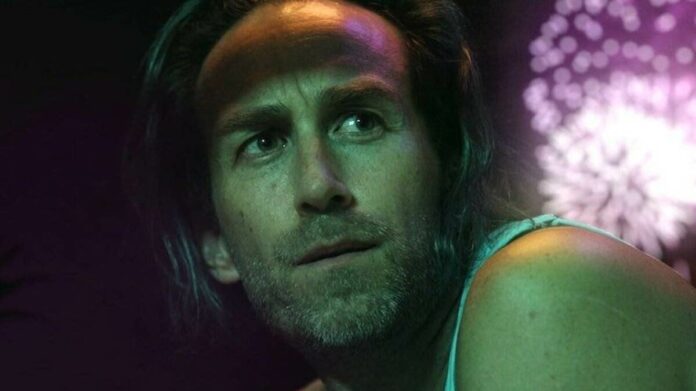By their very definition, conspiracy theories are explanations for events involving a conspiracy by sinister or powerful groups when the actual reasoning could be attributed to something far more simple and logical. It also deals with theories of the unexplainable by invoking circular reasoning or flowchart connectivity through events upon events that feel unconnected except through one or two overt symbolisms.
Justin Benson and Aaron Moorehead’s “Something in the Dirt” is one of the latest approaches in the “movies set during the pandemic” genre. The genre came into being as a method for artists to explore storytelling when characters are present in stifling conditions. From Bo Burnham’s “Inside” to Steven Soderbergh’s “Kimi,” there have been several movies in this genre divided into sub-genres. Benson and Moorehead’s approach here is to explore the esoteric nature inherent to civilization going through an event unexplainable by logical constructs. Levi (Justin Benson) moves into the same apartment complex as John (Aaron Moorehead), who has lived there for a decade. While exploring Levi’s newly christened “temporary digs,” they witness an anomaly in the form of multicolor lights washing through the entire living room and then levitating the crystal ashtray Levi found in the bathroom of the apartment while crafting spiral patterns on the wall. Initially shocked and curious, John and Levi decide to record the event, study it to find rational scientific reasoning, and craft a documentary out of it with the hope of selling it to Netflix. Things start getting complicated when John, while exploring the city, begins noticing the same spiral markings on the walls of churches, bricks of adjoining buildings, graffiti, etc. These connections lead to larger musings on the spiral’s origin, the geometric contours, which lead to an exploration of Los Angeles’ esoteric underbelly.
Also interesting and far more revealing is the playful meta aspect of the movie, where the film is interspersed with interview segments of both John and Levi and the editors of the documentary “Something in the Dirt.” The meta-commentary aspect of the story is fascinating not just because it is an interesting feature but because it acts as a satire against mind-bending movies like “Triangle” or “Primer.” Nonetheless, it manages to become a window into the character exploration of both of these protagonists, making you, as an audience member, wonder whether the events are a series of unexplainable ones cascading against each other or whether sinister motivations lurk beneath the surface. Both protagonists reveal insights into these characters via snippets of dialogue. It becomes grating in some regards, as Aaron and Moorehead are more focused on how much deeper down the rabbit hole these characters could go. It becomes grating to watch these characters stop midway and start rambling about a different obscure historical or paranormal context and somehow connect it to their event, which is slowly growing in scope and definition for them while also becoming completely indecipherable. But the playful nature of the film, complete with the DIY approach to filmmaking (handheld cameras, a healthy dose of film grain, and explanations and monologues interspersed with real-life footage or data dumps), make it a visually appealing motion picture. Lest we get disappointed with the payoff, or apparent lack of it, you tend to realize that the movie isn’t about solving the mystery but exploring the unknown. A sense of wonder and childlike glee permeates every frame, even as the film crafts an aesthetic with planes flying over perilously close to the buildings or black smoke rising due to forest fires, coating Los Angeles with an apocalyptic sheen. It complements the reasoning behind the characters’ curiosity about the events occurring, as every step brings them deeper into the esoterica of LA (Pythagorean cults, irrational numbers, etc.), and the Americans’ tendency to believe in the unreal slowly coalesces. In the final act, earthquakes become a signal for the anomaly to repeat, while gravity does not follow its own set of rules. The sound design is haunting and mysterious at the same time, complementing the cosmic horror vibes the movie manages to portray at its most insidious moments.
It all starts to feel circuitous, repetitive, and even dragging at times, but the overall energy in every frame of the film makes you believe you’re watching a passionate film school project or one of the old-school pseudo-documentaries as a passion project for an aspiring filmmaker. It helps excuse the directors turned actors’ sometimes stilted acting or dialogue delivery, but that feels more like a necessity due to the pandemic and social distancing in full swing at the time of filming. It is perhaps not a coincidence that the movie is dedicated to “making movies with friends” because “Something in the Dirt” works as an exploration of friends trying to rationalize the unexplainable and getting lost in the elixir of knowledge through stray strands and snapshots and connecting it with tenuous threads. There is an infectious joyousness to that, and the film imparts that same feeling of giddiness. A question might arise by the end as to whether the entire movie is a circuitous scheme by one of the protagonists to off the other. This again feels like pulling disconnected threads to get a concrete bigger picture but finding only more stray threads, which is exactly how the film wants you to feel.

